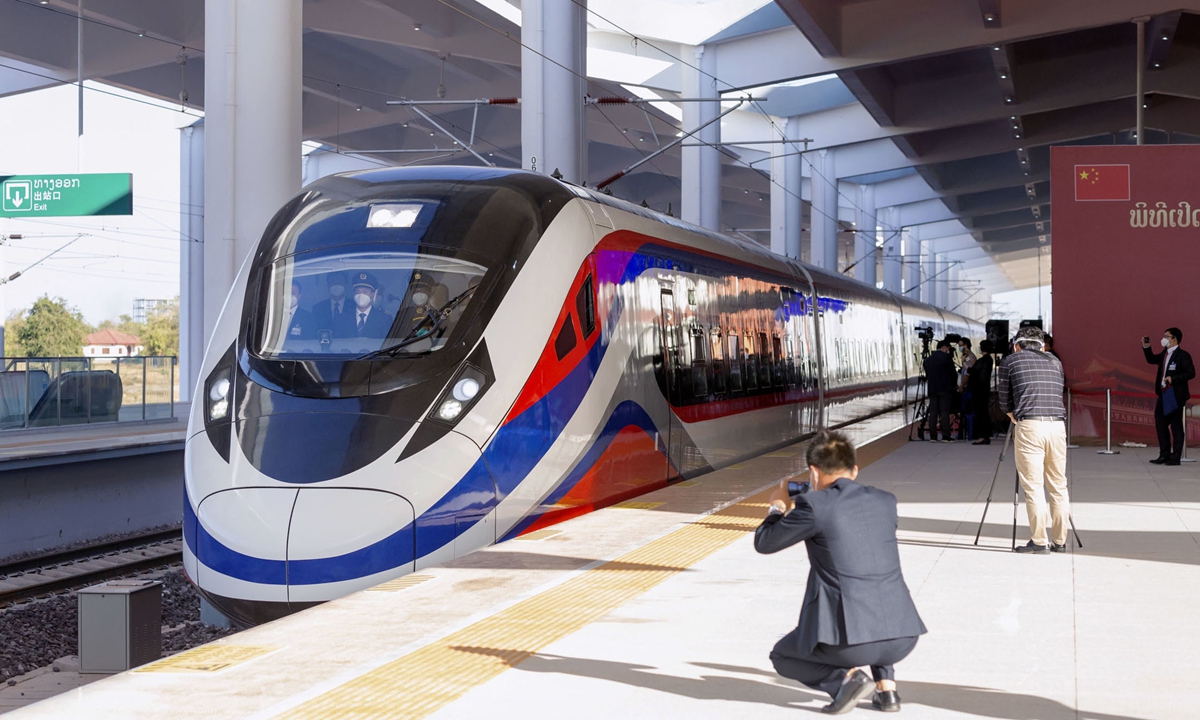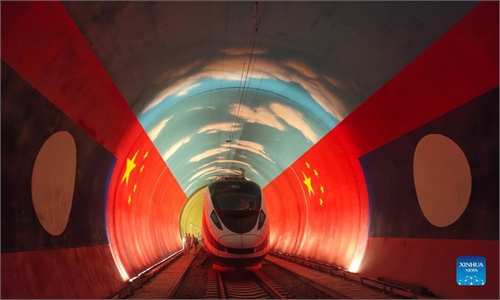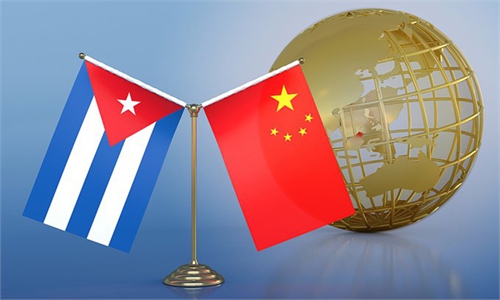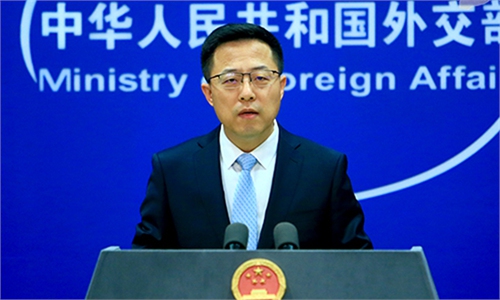Stakeholders look toward BRI infrastructure as RCEP trade pact set to boost China-ASEAN trade, investment
BRI, RCEP a booster for China-ASEAN cooperation

The first international cargo train along the 1,035-kilometer China-Laos Railway arrives in Vientiane, Laos,on December 4, 2021. Photo: VCG
Just 12 days after entering operation, the 1,035-kilometer-long China-Laos Railway, a signature project under the China-proposed Belt and Road Initiative (BRI), had carried cargo with total value exceeding 100 million yuan ($15 million).
During its first month, localities in China, including Southwest China's Yunnan, and East China's Shandong and Jiangsu, vied with each other to open their international freight railway links with the once landlocked, now land-linked nation.
As the Regional Comprehensive Economic Partnership Agreement (RCEP) will take effect at the end of this week, as agreed upon, the business community is awaiting the prospect and potential of the landmark regional trade pact, which is widely believed to greatly boost economic development in the region, and foster trade between China and the ASEAN, China's largest trading partner.
Merchants are planning to bank on what they see as a synergy of the economic benefits unleashed from the RCEP and the China-proposed BRI as China's economic and trade cooperation with ASEAN enters an new area of economic integration.
An employee from a Jiangsu-based logistics company told the Global Times that studies are being carried out to enlarge the business volume of railway freight to the Laos, as the railway will slash freight costs by half.
This year marks the 30th anniversary of the establishment of relations between China and ASEAN and the two sides are advancing the BRI and the Master Plan on ASEAN Connectivity by 2025.
In 2020, ASEAN members have jumped to be the number one trading bloc with China, with the trade volumes hitting 4.74 trillion yuan, a 7 percent growth year-on-year.
A Xinhua News Agency report noted that the BRI will drive the construction of the Trans-Asian Railway and promote regional connectivity.
Xu Liping, director of the Center for Southeast Asian Studies at the Chinese Academy of Social Sciences in Beijing, told the Global Times on Wednesday that as the essence of BRI lies in infrastructure and connectivity, it was certain that the initiative will work in synergy with the RCEP, which promotes and lifts up regional trade and investment.
To some, the China-Laos Railway is a concrete example that BRI infrastructure is helping and boosting trade due to its contribution to the regional supply chains.
Nattaporn Triratanasirikul, deputy managing director at Bangkok-based Kasikorn Research Center, told the Global Times that the BRI has laid down economic foundations in the region with infrastructure, trade, and financial connectivity.
"It will help support regional closer ties of trade and investment in the region after the RCEP takes effect," Triratanasirikul said.
China-ASEAN economic and trade relations have developed and established through regional supply chains, analysts have noted. RCEP, as an extending version of China-ASEAN free trade agreement, would help deepen trade ties between the two, while offer trade and investment opportunities through larger supply chains.
Nick Koay, chairman of the Malaysian Chamber of Commerce told the Global Times that he expected that more Chinese manufacturing companies would invest in Malaysia, especially in auto and auto component production.
In addition, despite ups and downs, the East Coast Rail Link, Malaysia's mega rail project, delivered in partnership with a Chinese contractor, is moving forward, Koay said, looking forward to more high-speed railway projects with China.
Shot in the arm
The RCEP pact, which creates the world's largest free trade bloc, will lift regional GDP by 0.86 percent and drive the real GDP growth of the entire world up by 0.12 percentage points and global foreign trade by 2.91 percent by 2035, a report by the Chinese Academy of International Trade and Economic Cooperation reported in November.
There will be a net increase of $857.1 billion in exports and $983.7 billion in imports for the region by 2035, from a base level, the report showed. Investment in the region will also be driven up by 1.47 percent.
The report also found that members of ASEAN will be the biggest beneficiaries of the pact in terms of GDP growth. An overall lift of 4.47 percent is forecast by 2035, with a 7.98-percent-increase for Cambodia; a 7.04-percent-gain for the Philippines and a 6.38-percent-increase for Thailand. Vietnam will see a 6.33-percent-increase in GDP.
Analysts have claimed that with the less trading friction, agricultural products and auto parts are likely to be two of the top items receiving the most immediate boost, notably from RCEP's trade facilitation clauses such as those on the Rule of Origins, which will enable ASEAN to import higher value-added inputs from East Asia and export higher value-added finished products to the plus 5 countries and its boost on regional investment.
Not only BRI's infrastructure boosts the development of physical trade and investment under the RCEP, the massive trade pact also works in a beneficiary way in the reverse, as it could potentially reduce the cost of construction for some of the key BRI projects currently still in the planning and development phase.
In Malaysia, stakeholders were already talking about the immediate benefits of RCEP in complementing the BRI.
A manager with China Railway Construction Corporation (CRCC), which is contracting the 191-kilometer-long Gemas-Johor Bahru railway electrification and upgrade project, told the Global Times on Wednesday that the coming into force of the RCEP deal could contribute "a major boon" to the railway project it is building in Malaysia.
The railway project, currently 84 percent complete, is also part of the Trans-Asian Railway network. The project has created 5,000 local jobs.
"Many of the traded goods will eventually enjoy zero-tariff rates and this is a great news for our project, which imports large amount of construction materials, the company said in its statement," the manager said.
Whereas BRI project places an emphasis on local procurement, there are also materials that need to be imported from China.
At the project site, 43,000 tons of steel tracks need to be procured from China, and this purchase stands to benefit from the RCEP. "We also understand that China-made bullet trains and locomotives, already impressing the clients with their cost performance, will likely see their chance of being finally picked by clients far increasing due to the effects of the RCEP deal," said the manager.
It is expected that reduced trade barriers and better facilitation as a result of the RCEP will allow faster integration of Chinese manufacturing companies into the regional supply chain in ASEAN as well as the world, paving way for broader Chinese railway model and standards exports, according to the CRCC statement sent to the Global Times.
Regional growth
China will continue to promote high-quality construction of the BRI with all parties in 2022 and aim to accelerate progress, a Chinese Foreign Ministry spokesperson said on Monday. Recently, Cuba became the newest BRI partner country, joining on December 24.
In the first 10 months of 2021, China's trade in goods with its BRI partners grew by 23 percent despite global headwinds, according to the ministry.
Flagship projects like the Piraeus Port, the Gwadar Port, and the Hungary-Serbia Railway are making steady progress, according to the ministry.
China-Europe Railway Express also saw accelerated growth in freight services and cargo volume.
China's trade with 14 other RCEP signatories accounts for 31 percent of its total foreign trade in first 11 months of 2021, data from the General Administration of Customs showed on Wednesday.
Analysts said that the fact that BRI has made steady progress also comes with China's honoring of its promise of enabling inclusive and high-quality growth along BRI routes. This could serve as a reference point with the US-led G7 initiative known as the Build Back Better World (B3W), essentially a political stunt.





